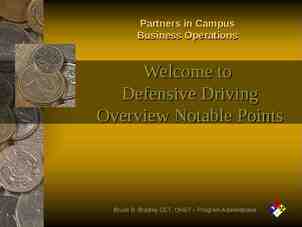SWOT Analysis S W O T
35 Slides493.12 KB
SWOT Analysis S W O T
What is SWOT Analysis? Technique is credited to Albert Humphrey who led a research project at Stanford University in the 1960s and 1970s. Strengths Oppurtunity SWOT Analysis Threats Weakness Planning tool used to understand Strengths, Weaknesses, Opportunities, & Threats involved in a project / business. 0r A strategic planning tool that separates influences on a business’s future success into internal and external factors.
SWOT Analysis The overall evaluation of a company’s strengths, weaknesses, opportunities, and threats is called SWOT analysis. It’s a way of monitoring the external and internal marketing environment. Technique that enables a group / individual to move from everyday problems / traditional strategies to a fresh perspective.
When SWOT analysis is done Is often created during a retreat or planning session that allows several hours for both brainstorming and more structured analysis. The best results come when participants are encouraged to have an open attitude about possibilities.
SWOT Analysis SWOT is a summary of your Strengths Weaknesses Opportunities Threats Interna l Externa l
SWOT analysis examines four elements Strengths and Weaknesses are considered internal factors---meaning you as the business owner can control them. Strengths - internal attributes and resources that support a successful outcome. Weaknesses - internal attributes resources that work against a successful outcome. .
SWOT analysis examines four elements Opportunities and Threats are considered external factors---meaning you have little control over them. It is your job as a business owner to respond appropriately Opportunities - external factors the project can use to its advantage. Threats - external jeopardize the project. factors that could
STRENGTHS Characteristics of the team that give it an others in the industry. business advantage or a over Positive tangible and intangible attributes, internal to an organization. Beneficial aspects of the organization or the capabilities of an organization, which includes human competencies, process capabilities, financial resources, products and services, customer goodwill and brand loyalty. Examples -, Well-known brand name,, Lower costs [raw materials or processes], Superior management talent, Better marketing skills, Good distribution skills, Committed employees.
WEAKNESSES Characteristics that place the firm at a disadvantage relative to others. Detract the organization from its ability to attain the core goal and influence its growth. Weaknesses are the factors which do not meet the standards we feel they should meet. However, sometimes weaknesses are controllable. They must be minimized and eliminated. Examples - Limited financial resources, Limited distribution, Higher costs, Outof-date products / technology, Weak market image, Poor marketing skills, Limited management skills.
OPPORTUNITIES Chances to make greater profits in the environment - External attractive factors that represent the reason for an organization to exist & develop. Arise when an organization can take benefit of conditions in its environment to plan and execute strategies that enable it to become more profitable. Organization should be careful and recognize the opportunities and grasp them whenever they arise. Opportunities may arise from market, competition, industry/government and technology. Examples - Rapid market growth, Changing customer needs/tastes, New uses for product discovered,Sales decline for a substitute product .
THREATS External elements in the environment that could cause trouble for the business - External factors, beyond an organization’s control, which could place the organization’s mission or operation at risk. Arise when conditions in external environment jeopardize the reliability and profitability of the organization’s business. Examples - Entry of foreign competitors, Changing customer needs/tastes, Rival firms, adopt new strategies, Increased government regulation, Economic downturn. !
How do you use SWOT analysis Identify the issues or problems you intend to change. Set or reaffirm goals. Create an action plan.
INTERNAL ENVIRONMENT (STRENGTHS AND WEAKNESSES) ANALYSIS Each business needs to evaluate its internal strengths and weaknesses. Clearly, the business doesn’t have to correct all its weaknesses, nor should it overwhelmed about all its strengths. The big question is whether it should limit itself to those opportunities for which it possesses the required strengths, or consider those that might require it to find or develop new strengths. Managers at Texas Instruments (TI) were split between those who wanted to stick to industrial electronics, where TI has clear strength, and those who wanted to continue introducing consumer products, where TI lacks some required marketing strengths.
Businesses can evaluate their own strengths and weaknesses by using a form like the one shown in “Marketing Memo: Checklist for Performing Strengths/Weaknesses Analysis.”
EXTERNAL ENVIRONMENT (OPPORTUNITY AND THREAT) ANALYSIS A business unit must monitor key macroenvironment forces( uncontrollable by the company like include competitors, changes in interest rates, changes in cultural tastes, disastrous weather, or government regulations). and significant microenvironment factors (controllable by the company like 1. workers and their union, 2. customers, 3. suppliers, 4. public, 5. marketing intermediaries) that affect its ability to earn profits. It should set up a marketing intelligence system to track trends and important developments and any related opportunities and threats. Good marketing is the art of finding, developing, and profiting from these opportunities.
Marketers need to be good at spotting opportunities. Consider the following: A company may benefit from converging industry trends and introduce hybrid products or services that are new to the market. Major cell manufacturers have released phones with digital photo and video capabilities, and Global Positioning Systems (GPS). A company may make a buying process more convenient or efficient. Consumers can use the Internet to find more books than ever and search for the lowest price with a few clicks. A company can meet the need for more information and advice. Angie’s List connects individuals with local home improvement contractors and doctors that have been reviewed by others.
A company can customize a product or service. Timberland allows customers to choose colors for different sections of their boots, add initials or numbers to their boots, and choose different stitching and embroidery. A company can introduce a new capability. Consumers can create and edit digital “iMovies” with the iMac and upload them to an Apple Web server or Web site such as YouTube to share with friends around the world. A company may be able to deliver a product or service faster. FedEx discovered a way to deliver mail and packages much more quickly than the U.S. Post Office. A company may be able to offer a product at a much lower price. Pharmaceutical firms have created generic versions of brand-name drugs, and mail-order drug companies often sell for less.
Opportunity and threat Matrix
Discussion of O-T matrix In the opportunity matrix in Figure (a), the best marketing opportunities facing the TVlighting-equipment company appear in the upper-left cell (#1). The opportunities in the lower-right cell (#4) are too minor to consider. The opportunities in the upperright cell (#2) and the lower-left cell (#3) are worth monitoring.
Discussion of O-T matrix An environmental threat is a challenge posed by an unfavorable trend or development that, in the absence of defensive marketing action, would lead to lower sales or profit. Figure (b) illustrates the threat matrix facing the TVlighting-equipment company. The threats in the upper-left cell are major, because they have a high probability of occurrence and can seriously hurt the company. To deal with them, the company needs contingency plans. The threats in the lower-right cell are minor and can be ignored. The firm will want to carefully monitor threats in the upperright and lower-left cells in the event they grow more serious.
SWOT matrix STRENGTHS 1. 2. 3. WEAKNESSES 1. 2. 3 OPPORTUNITIES 1. 2. 3. 4. (OS) Strategies Use strengths to take advantage of opportunities 1. 2 Using a strength to maximise an opportunity (OW) Strategies overcome weaknesses by taking advantage of opportunities 1. 2 Improving capability to maximise an opportunity THREATS 1. 2. 3. 4. (TS) Strategies Use strengths to avoid threats 1. 2. Minimising a threat with a strength (TW) Strategies Minimize weaknesses and avoid threats 1. 2. Minimising weaknesses and threats at same time (often last choice)
Goal Formulation Once the company has performed a SWOT analysis, it can proceed to goal formulation, developing specific goals for the planning period. Goals are objectives that are specific with respect to magnitude and time. Most business units pursue a mix of objectives, including profitability, sales growth, market share improvement, risk containment, innovation, and reputation. The business unit sets these objectives and then manages by objectives (MBO).
MBO system For an MBO system to work, the unit’s objectives must meet four criteria. 1. They must be arranged hierarchically, from most to least important. 2. Objectives should be quantitative whenever possible. The objective “to increase the return on investment (ROI)” is better stated as the goal “to increase ROI to 15 percent within two years.” 3. Goals should be realistic. Goals should arise from an analysis of the business unit’s opportunities and strengths, not from wishful thinking. 4. Objectives must be consistent. It’s not possible to maximize sales and profits simultaneously.
SWOT Analysis allows businesses to Define realistic goals Improve capability Overcome weaknesses with strengths Identify threats than can be turned into opportunities( opportunity to improve).
Tips & Exercise EXAMPLE Mc Donald’s SWOT Analysis
Tips & Exercise Mc Donald’s SWOT Analysis INTERNAL INTERNAL STRENGTHS STRENGTHS WEAKNESSES WEAKNESSES Community oriented Global operations all over the world Cultural diversity in the foods Excellent location High training costs due to high turnover. Not much variation in seasonal products . Quality concerns due to franchised operations. Focus on burgers / fried foods not on healthier options for their customers. OPPORTUNITIES OPPORTUNITIES THREATS THREATS Opening more joint ventures. Being more responsive to healthier options. Expanding on the advertising on being more socially responsible Expansions of business into newly developed parts of the world. Marketing strategies that entice people from small children to adults. Lawsuits for offering unhealthy foods. The vast amount of fast food restaurants that are open as competition. Down turn in economy affecting the ability to eat EXTERNAL EXTERNAL
The SWOT Framework SWOT Analysis Framework Environmental Scan / \ Internal Analysis External Analysis / \ / \ Strengths Weaknesses Opportunities Threats SWOT Matrix
Application of SWOT analysis considering any therapeutic class of a drug( Cefuroxime axetil)
Cefuroxime axetil CEFTIN tablets and Ceftin for oral suspension contain cefuroxime as cefuroxime axetil.CEFTIN is a semisynthetic broadspectrum antibiotic for oral administration.
Strength Clinical PharmacologyAbsorption and metabolism-after oral administration CA is absorbed from G.I.T. and rapidly hydrolyzed by nonspecific esterases in the intestinal mucosa and blood to cefuroxime. Cefuroxime is subsequently distributed thoughout the extracellular fluids. The axetil moiety is metabolized to acetaldehyde and acetic acid.
Strength Indications and use Pharyngitis and tonsilitis. Acute bacterial otitis media. Acute maxillary sinusitis. Acute bacterial exacerbation of chronic bronchitis and secondary bacterial infection of acute bronchitis. Uncomplicated skin infection.
Weakness Side effectsAllergic reaction Difficulty in breathing,swelling of face, lips,tongue,throat. Diarrhoea Fever, chills, body aches, flu symptoms. Chest pain, fast heart beat. Unusual bleeding. Blood in urine. Seizures Pale or yellow skin Dark colour urine Fever Jaundice
Opportunity Pseudomembranous colitis has been reported to be associated with the use of cefuroxime axetil and other broad spectrum antibiotics. So it is important to consider it’s diagnosis in patients administering cefuroxime axetil who develop diarrhoea. Treatment with broad spectrum antibiotic including cefuroxime axetil alters normal flora of the colon and may permit overgrowth of clostridia. Studies indicate that a toxin produced by C. difficile is one primay cause of antibiotic associated colitis.Mild cases of colitis may respond to the drug discontinuty.
Opportunity Moderate to severe cases should be managed with fluid electrolyte. When the colitis is severe or not relieved discontinuance of cefuroxime axetil administration, consideration should be given to the administration of the oral vancomycin or other suitable therapy.
Threat In the present time in India lots of Pharmaceutical company produce this type of the drug and doctors should be prescribed this drug too much for the treatment.Many pharmaceutical industry produce this category drug with parenteral route also and with varying prices.








































